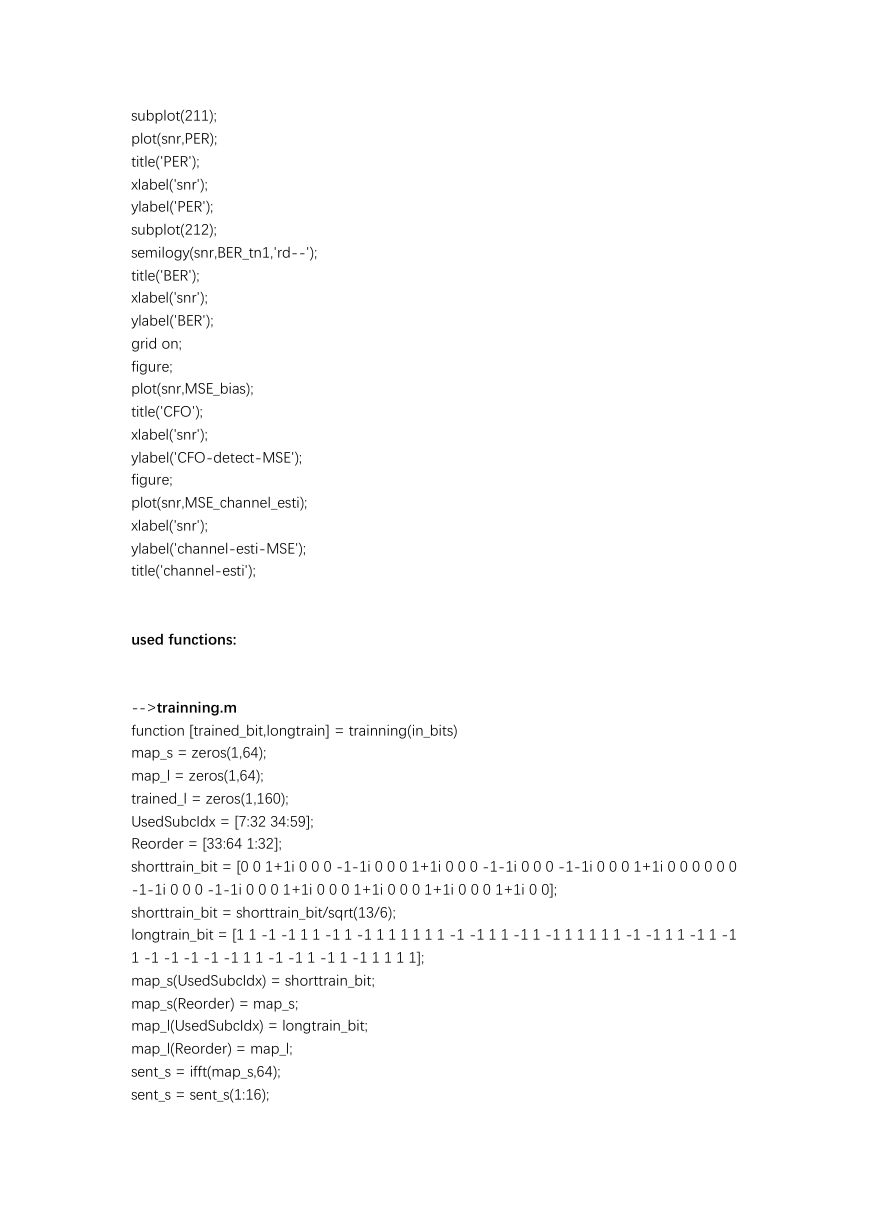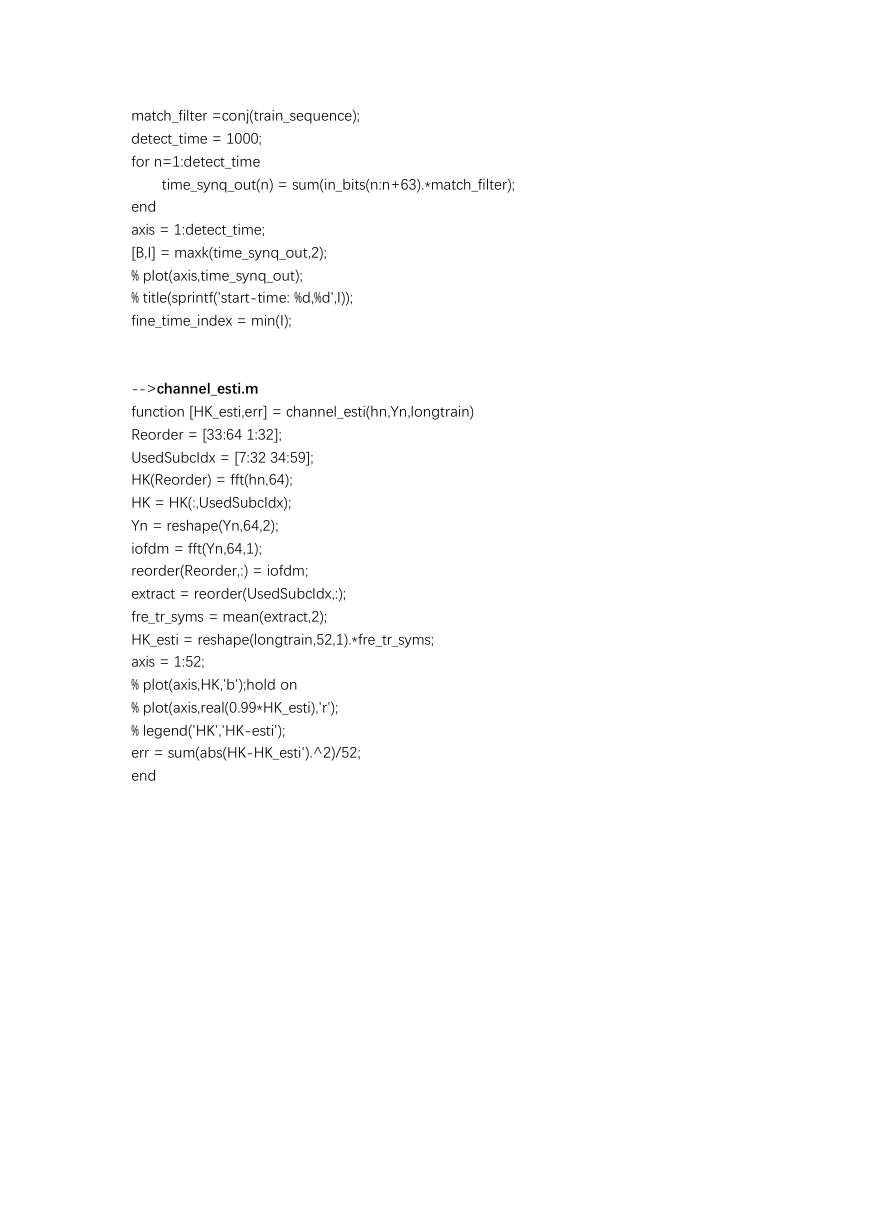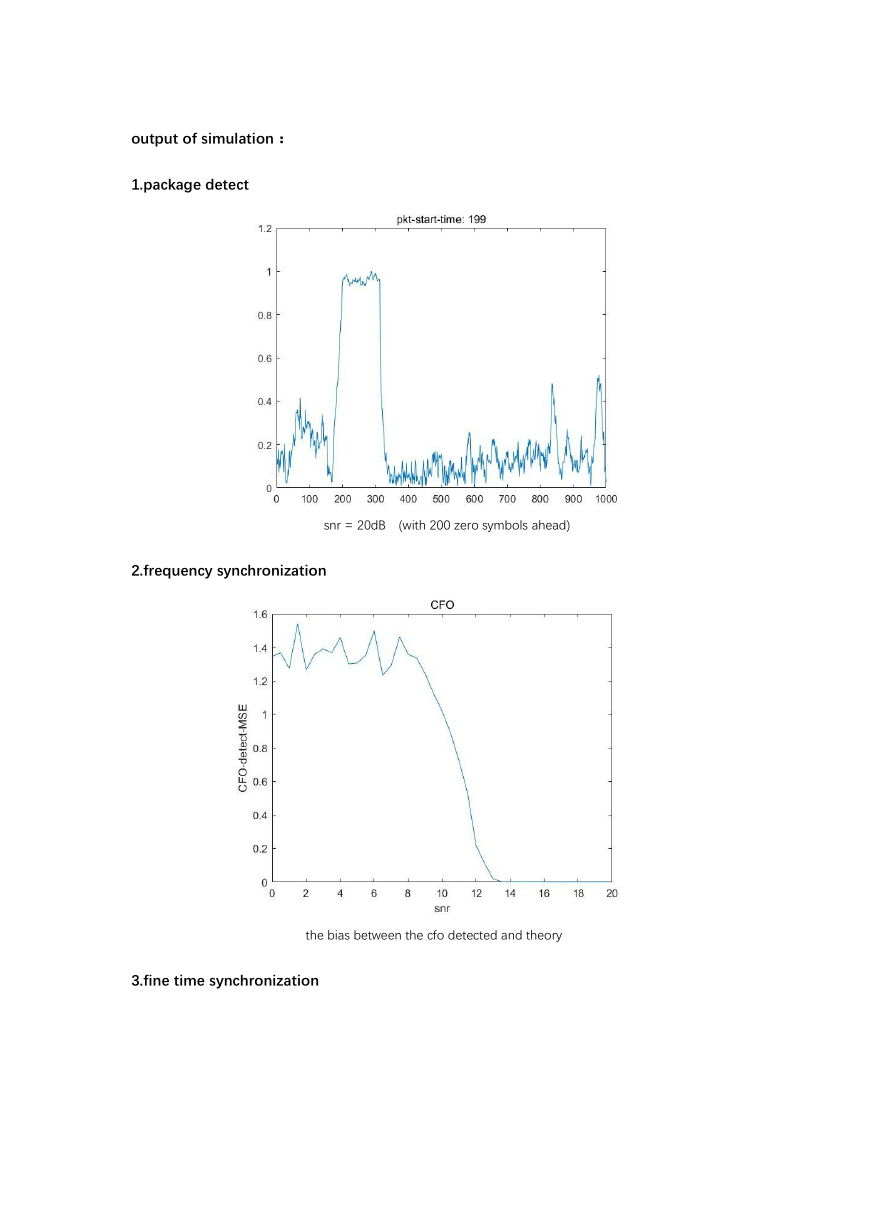Final assignment
leolei
In this final assignment, we respectively attempt to build a complete ofdm system and the
following is a combine summary of our each’s work.
part one
-->code:
-->main.m
clc
clear
close all
%% 基础信息
m = 2;%调制等级(QAM)
N = 100;%发射 OFDM 块个数
num_bit = N*m*48/2;%输入二进制比特个数
pilot_out = zeros(N,52)';%插入导频输出
map_out = zeros(N,64)';%mapping 输出
%insert-pilot&mapping 索引
%###############
DataSubcPatt = [1:5 7:19 21:26 27:32 34:46 48:52];
PilotSubcPatt = [6 20 33 47];
UsedSubcIdx = [7:32 34:59];
Reorder = [33:64 1:32];
%###############
%% 测试
N_tn2 = 250;
snr = 12:0.1:16;
for tn1=1:length(snr)
counter = 0;
for tn2=1:N_tn2
%% %%%%%%%%%%%%################发射端###########################
%%%%%%%信道编码
in_bit = randi([0,1],1,num_bit);%输入随机二进制流
trellis = poly2trellis(7,[133,171]);%生成卷积编码码树
conv_encode_bit = convenc(in_bit,trellis);%1/2 卷积信道编码
%%%%%%%交织
interleaved_bits = tx_interleaver(conv_encode_bit,48, m);
%%%%%%%m 阶 QAM 调制
qam_in = reshape(interleaved_bits,num_bit*2/m,m);%串并转换
qam_out = qammod(bi2de(qam_in),2.^m,'UnitAveragePower',true);%qam 调制
%%%%%%%mapping
%插入导频
�
pilot_in = reshape(qam_out,48,N);%串并转换
pilot_out(DataSubcPatt,:) = pilot_in;
pilot_out(PilotSubcPatt,:) = 1;%映射
%映射至子载波
map_out(UsedSubcIdx,:) = pilot_out;%映射
map_out(Reorder,:) = map_out;%重新排序
%%%%%%%IFFT(ofdm-mod)
ofdm = ifft(map_out,64,1);
%%%%%%%add_cp
s_cp = [ofdm(64-15:64,:);ofdm];
s_cp = reshape(s_cp,N*80,1);
%%%%%%%training
[trained_sent,longtrain] = trainning(s_cp);
%% %%%%%%%%%%%%################信道##############################
SNR = snr(tn1);
h = [1,0.1,0.2];
%%%%%%%加入空白前缀
zero_time = 200;
add_zeroinfo = [zeros(1,zero_time)';trained_sent;zeros(1,1000)'];
%%%%%%%加入频偏
period = length(add_zeroinfo);
axis_time = 1:period;
bias = 0.01;
fre_bias = exp(-1i*2*pi/64*axis_time*bias)';
add_fre_bias = add_zeroinfo.*fre_bias;
%%%%%%%%过多径信道
after_h = filter(h,1,add_fre_bias);
%%%%%%%%加噪声
after_noise = awgn(after_h,SNR,'measured');
%% %%%%%%%%%%%%################接收端############################
%%%%%%%包检测 ok
pkt_detect_index = pkt_detect(after_noise);
%%%%%%%频率同步 ok
freq_synq_out = freq_synq(after_noise,pkt_detect_index);
bias_detect = 2*freq_synq_out/pi;
bias_detect_perf(tn2) = bias-bias_detect;
freq_compensation = exp(-1i*2*pi/64*axis_time*bias_detect)';
after_freq_compen = after_noise.*freq_compensation;
%after_freq_compen = after_noise;
err_fre_synq = sum((add_zeroinfo - after_freq_compen).^2)/period;
%%%%%%%%精准时间同步 ok
start_time = fine_time_synq(after_freq_compen,trained_sent(257:320));
r_cp = after_freq_compen(start_time+128:start_time+128+80*N-1);
%%%%%%%remove_cp
�
r_cp = reshape(r_cp,80,N);
r = r_cp(17:end,:);
%%%%%%%FFT(ofdm-demod)
iofdm = fft(r,64,1);
%%%%%%%demapping
demap_in(Reorder,:) = iofdm;%排序恢复
demap_out = demap_in(UsedSubcIdx,:);
%%%%%%%信道估计 ok
[HK_esti,err_esti] = channel_esti(h,after_freq_compen(start_time:start_time+127),longtrain);
channel_esti_perf(tn2) = err_esti;
%%%信道均衡
for n=1:length(demap_out)
after_equa(:,n) = demap_out(:,n)./HK_esti;
end
%%%%%%%%
depilot_out = after_equa(DataSubcPatt,:);
pilot_syms_out = after_equa(PilotSubcPatt,:);
%%%%%%%%相位补偿
phase_esti = angle(sum(pilot_syms_out));
phase_comp = exp(-j*phase_esti);
after_phase_comp = depilot_out.*repmat(phase_comp,48,1);
%%%%%%%m 阶 QAM 解调
deqam_in = reshape(after_phase_comp,num_bit*2/m,1);
deqam_bit = de2bi(qamdemod(deqam_in,2.^m,'UnitAveragePower', true));
deqam_out = reshape(deqam_bit,1,num_bit*2);
%%%%%%%解交织
deint_bits = rx_deinterleave(deqam_out, 48, m);
%%%%%%%信道译码
conv_decode_bit = vitdec(deint_bits,trellis,35,'trunc','hard');
%%%%%%%输出检测误码率和丢包率
out_bit = conv_decode_bit;
BER_tn2(tn2) = sum(abs(in_bit-out_bit))/num_bit;
if BER_tn2(tn2)~=0
counter = counter+1;
end
BER_tn2(tn2) = BER_tn2(tn2) + 1e-20;
end
BER_tn1(tn1) = sum(BER_tn2)/N_tn2;
PER(tn1) = counter/N_tn2;
MSE_bias(tn1) = sum(bias_detect_perf.^2)/N_tn2;
MSE_channel_esti(tn1) = sum(channel_esti_perf.^2)/N_tn2;
disp(tn1);
end
figure;
�
subplot(211);
plot(snr,PER);
title('PER');
xlabel('snr');
ylabel('PER');
subplot(212);
semilogy(snr,BER_tn1,'rd--');
title('BER');
xlabel('snr');
ylabel('BER');
grid on;
figure;
plot(snr,MSE_bias);
title('CFO');
xlabel('snr');
ylabel('CFO-detect-MSE');
figure;
plot(snr,MSE_channel_esti);
xlabel('snr');
ylabel('channel-esti-MSE');
title('channel-esti');
used functions:
-->trainning.m
function [trained_bit,longtrain] = trainning(in_bits)
map_s = zeros(1,64);
map_l = zeros(1,64);
trained_l = zeros(1,160);
UsedSubcIdx = [7:32 34:59];
Reorder = [33:64 1:32];
shorttrain_bit = [0 0 1+1i 0 0 0 -1-1i 0 0 0 1+1i 0 0 0 -1-1i 0 0 0 -1-1i 0 0 0 1+1i 0 0 0 0 0 0
-1-1i 0 0 0 -1-1i 0 0 0 1+1i 0 0 0 1+1i 0 0 0 1+1i 0 0 0 1+1i 0 0];
shorttrain_bit = shorttrain_bit/sqrt(13/6);
longtrain_bit = [1 1 -1 -1 1 1 -1 1 -1 1 1 1 1 1 1 -1 -1 1 1 -1 1 -1 1 1 1 1 1 -1 -1 1 1 -1 1 -1
1 -1 -1 -1 -1 -1 1 1 -1 -1 1 -1 1 -1 1 1 1 1];
map_s(UsedSubcIdx) = shorttrain_bit;
map_s(Reorder) = map_s;
map_l(UsedSubcIdx) = longtrain_bit;
map_l(Reorder) = map_l;
sent_s = ifft(map_s,64);
sent_s = sent_s(1:16);
�
trained_s = sent_s;
sent_l = ifft(map_l,64);
for i=1:9
trained_s = [trained_s sent_s];
end
trained_l(1:32) = sent_l(33:64);
trained_l(33:96) = sent_l;
trained_l(97:160) = sent_l;
x = reshape([trained_s trained_l],320,1);
trained_bit = [x;in_bits];
longtrain = longtrain_bit;
-->pkt_detect.m
function pkt_detect_index = pkt_detect(in_bits)
LA = 32;
count = 1;
standard = 0.85;
detect_time = 1000;
for n=1:detect_time
C(n) = abs(sum(in_bits(n:(n+LA-1)).*conj(in_bits((n+16):(n+15+LA)))));
P(n) = sum(abs(in_bits((n+16):(n+LA+15))).^2);
if ((C(n)/P(n))>standard)&(count==1)
count = n;
end
end
axis = 1:detect_time;
m = C./P;
% plot(axis,m);
% title(sprintf('pkt-start-time: %d',count));
pkt_detect_index = count;
-->freq_synq.m
function freq_synq_out = freq_synq(in_bits,pkt_detect_index)
offset = 20;
synq_bit = in_bits(pkt_detect_index:end);
R = sum(synq_bit(offset:(16*2+offset)).*conj(synq_bit((offset+16):(3*16+offset))));
angle_R = angle(R);
freq_synq_out = angle_R;
-->fine_time_synq.m
function fine_time_index = fine_time_synq(in_bits,train_sequence)
�
match_filter =conj(train_sequence);
detect_time = 1000;
for n=1:detect_time
time_synq_out(n) = sum(in_bits(n:n+63).*match_filter);
end
axis = 1:detect_time;
[B,I] = maxk(time_synq_out,2);
% plot(axis,time_synq_out);
% title(sprintf('start-time: %d,%d',I));
fine_time_index = min(I);
-->channel_esti.m
function [HK_esti,err] = channel_esti(hn,Yn,longtrain)
Reorder = [33:64 1:32];
UsedSubcIdx = [7:32 34:59];
HK(Reorder) = fft(hn,64);
HK = HK(:,UsedSubcIdx);
Yn = reshape(Yn,64,2);
iofdm = fft(Yn,64,1);
reorder(Reorder,:) = iofdm;
extract = reorder(UsedSubcIdx,:);
fre_tr_syms = mean(extract,2);
HK_esti = reshape(longtrain,52,1).*fre_tr_syms;
axis = 1:52;
% plot(axis,HK,'b');hold on
% plot(axis,real(0.99*HK_esti),'r');
% legend('HK','HK-esti');
err = sum(abs(HK-HK_esti').^2)/52;
end
�
output of simulation:
1.package detect
snr = 20dB (with 200 zero symbols ahead)
2.frequency synchronization
the bias between the cfo detected and theory
3.fine time synchronization
�
snr = 20dB (with 200 zero symbols ahead)
4.channel estimation
single estimation
�
















 2023年江西萍乡中考道德与法治真题及答案.doc
2023年江西萍乡中考道德与法治真题及答案.doc 2012年重庆南川中考生物真题及答案.doc
2012年重庆南川中考生物真题及答案.doc 2013年江西师范大学地理学综合及文艺理论基础考研真题.doc
2013年江西师范大学地理学综合及文艺理论基础考研真题.doc 2020年四川甘孜小升初语文真题及答案I卷.doc
2020年四川甘孜小升初语文真题及答案I卷.doc 2020年注册岩土工程师专业基础考试真题及答案.doc
2020年注册岩土工程师专业基础考试真题及答案.doc 2023-2024学年福建省厦门市九年级上学期数学月考试题及答案.doc
2023-2024学年福建省厦门市九年级上学期数学月考试题及答案.doc 2021-2022学年辽宁省沈阳市大东区九年级上学期语文期末试题及答案.doc
2021-2022学年辽宁省沈阳市大东区九年级上学期语文期末试题及答案.doc 2022-2023学年北京东城区初三第一学期物理期末试卷及答案.doc
2022-2023学年北京东城区初三第一学期物理期末试卷及答案.doc 2018上半年江西教师资格初中地理学科知识与教学能力真题及答案.doc
2018上半年江西教师资格初中地理学科知识与教学能力真题及答案.doc 2012年河北国家公务员申论考试真题及答案-省级.doc
2012年河北国家公务员申论考试真题及答案-省级.doc 2020-2021学年江苏省扬州市江都区邵樊片九年级上学期数学第一次质量检测试题及答案.doc
2020-2021学年江苏省扬州市江都区邵樊片九年级上学期数学第一次质量检测试题及答案.doc 2022下半年黑龙江教师资格证中学综合素质真题及答案.doc
2022下半年黑龙江教师资格证中学综合素质真题及答案.doc